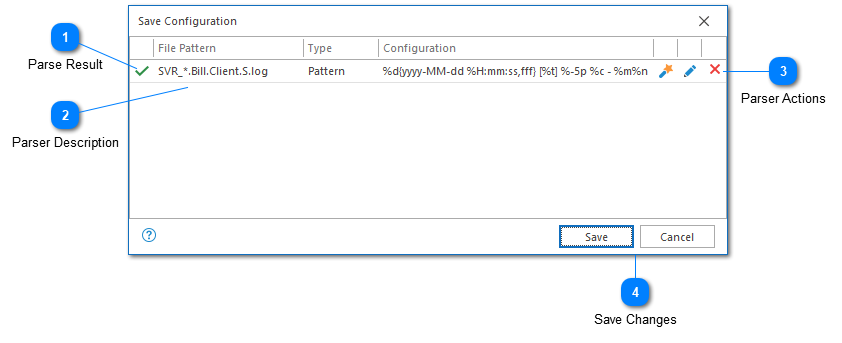Automatic Configuration

Automatic parser configuration is designed to give you a head start in creating a valid parser for your log file by dramatically lowering the learning curve. However, it still useful to understand how parser configurations work. In particular, it's important to understand how LogViewPlus assigns data to columns.
If LogViewPlus is able to automatically generate a parser configuration it will display the dialog show above which will give you an opportunity to modify and save the generated configuration. Multiple configurations can be managed at the same time. Saved configurations can be removed in the Parser Mappings application settings.
There are a couple of things you should double check in the automatically generated configuration before saving. If you are familiar with configuring parsers, then you can easily review these settings in the Parser Configuration Dialog by clicking on the pencil icon.
First, does the filename pattern makes sense? The generated filename pattern will automatically wildcard numbers and symbols which may be detected in the log file name. Often, this pattern can be made more generic to match a wider variety of filenames. For example, in the screenshot above the name SVR_*.log would likely be sufficient and match a wider variety of files. File name patterns should match only the log files which are written in the same log entry format.
Second, do the column names suggested by the generated configuration make sense? For example, if the generated configuration suggests String Columns, then default column names will be used such as Column1 and Column2. These names should be modified to better identify your data.
Finally, the automatically generated configuration will attempt to identify the thread and logger columns based on inbuilt heuristics. This best effort approach can be problematic and you should review the decisions made by LogViewPlus to ensure they are correct.
Parse Result
The parse result is indicated by an icon located in the far left of the dialog. Hovering over this icon will provide a tooltip with a detailed description of the parse result. This message can also be seen by clicking on the icon.
Parser Description
A brief description of the pattern is shown including the file name pattern suggested, the type of parser used, and the configuration used for the parser. Double clicking on this description will allow you to edit the parser configuration settings in the Parser Wizard.
Parser Actions
Three actions are available in the far right of the dialog. These actions allow you to:
1. Edit the parser configuration using the Parser Wizard.
2. Edit the parser configuration using the standard Parser Configuration Dialog.
3. Remove the configuration. If the configuration is removed, it cannot be saved.
Save Changes
If you are happy with the parser configurations, you can save them to your application settings. Saving the parser configurations will prevent this dialog from appearing the next time you open a file matching one of the file name patterns provided.
You can also cancel the changes if you do not want to save the parser configurations.